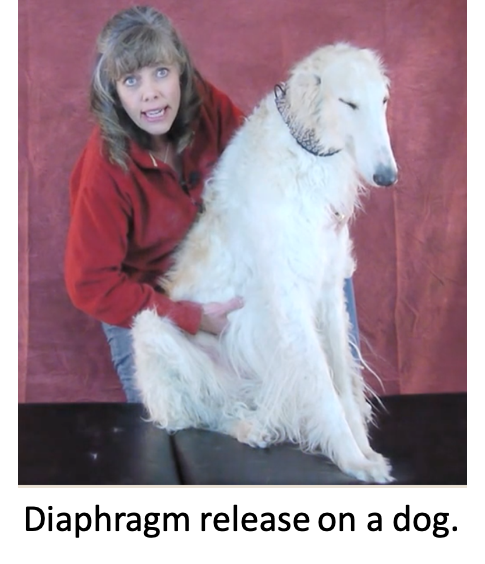| print
link to this post | email a friend The Diaphragm, Physio, and the Myofascial System24 Sep 2021 Over the last few years, I’ve had a couple of cases that involved the diaphragm. In each case, it was on a whim that I decided to do a diaphragm release. Or rather, I had found very little wrong with these dogs, and so decided I needed to think outside the box, and assess the diaphragm.
One case was a young male dog that competed in obedience and field trialing, and has a few different issues over the years. The owner had noticed that his ‘fronts’ weren’t quite straight (i.e. when he would sit directly in front of the owner in an competition / training session, he was a bit crooked). So, when I assessed him and found nothing in the usual places, I thought, ‘Why not see what the diaphragm is doing?’
So, I slowly pressed into the area under the rib cage and one side was far more tender and taut than the other side. Subsequently, I did a diaphragm release. (Essentially pressing into the diaphragm, with some lateral bend towards the affected side, and then repositioning.) Who knew what it would do. Well, just a couple of days ago, the owner messaged me that she though his fronts were better! Wow!
Another case that comes to mind was a Weimaraner with a very slight ‘bump’ in his spine. Not quite a roach. But a less than flat back. He was another one that I found very little on musculoskeletal evaluation. So again, I assessed the diaphragm, found one side tender, and did a release technique. Voila!! With this dog, his spine looked a bit flatter right away. His owner was delighted.
What was fascinating to me is that in both cases, I had no idea what to expect and quite honestly, didn’t think that it would do much of anything. So, with both of these cases, I realized that I really should be checking the diaphragm more and subsequently, I have been!
Other correlations I’ve made of the years are to assess the diaphragm in all dogs with iliopsoas strains. That’s the hip flexor muscle deep in front of the hip. I’ve also found a correlation with dogs that have had rib problems and pain. As well, dogs that have been favouring a leg (i.e. holding it up or off the ground slightly). They tend to have tight diaphragms as well.
Basically, because of the myofascial system (the cotton candy-like fuzz that covers all of your tissues, is between your tissues, and essentially hold you together), there can be innumerable correlations to be made and found where one issue has an impact on another structure.
All of this to say that the physios here at The Canine Fitness Centre Ltd. are always thinking outside of the box and learning new techniques, new correlations, and new ways to make your dogs (or occasionally your cat) feel fabulous!
Feel free to ask about questions about fascia! We are total nerds that like to talk-shop and would be happy to share knowledge on this subject!
Until next time… Cheers! Laurie Edge-Hughes, BScPT, MAnimSt (Animal Physio.), CAFCI, CCRT
|

|



